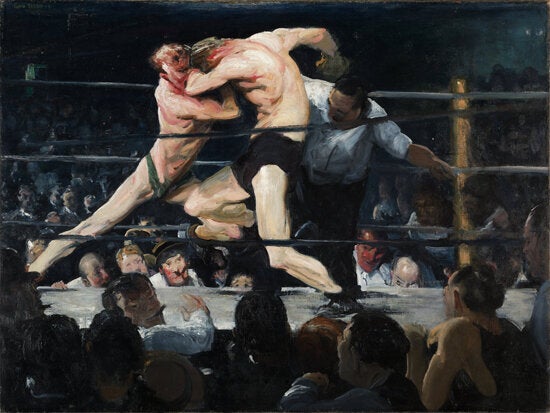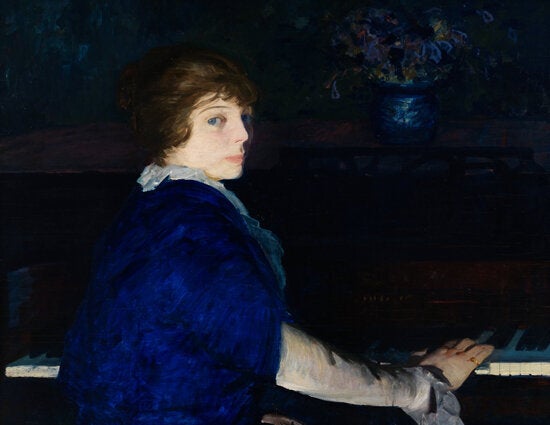George Bellows (1882 - 1925) is often associated with the violent depiction of boxing matches at the turn of the 20th century in America. Works like Stag at Sharkey's (1909) and Both Members of this Club (1909) show the bloody mess and ultra violence in the ring of a then often illegal and brutal spectator sport. The reaction of a genteel Edwardian museum goer to these paintings might compare with a modern viewer's shock on first viewing Fight Club (1999). Bloodied faces mashed in pain, striped male bodies glistening with sweat and a bit of fear became his visual calling card.

George Bellows, Stag at Sharkey's, 1909, oil on canvas, 92 x 112.6 cm, The Cleveland Museum of Art, Hinman B. Hurlbut Collection, © The Cleveland Museum of Art
This excellent exhibition at the Royal Academy (travelling from the US at the Metropolitan, New York and the National Gallery of Art, Washington) does the artist a great service by highlighting not only these works but the much quieter ones of the women he loved.

George Bellows, Emma at the Piano, 1914, oil on panel, 73 x 94 cm, Chrysler Museum of Art, Norfolk, Gift of Walter P. Chrysler, Jr., Photo © Courtesy of the Bellows Trust
Time and again he painted his wife Emma (they married in 1910) and a vast number of female nudes. From one of the earliest Nude Girl, Miss Leslie Hall (1909) to those just before his death Nude with Hexagonal Quilt (1924) and Two Women (1924), Bellows was as enamoured of female flesh as Thomas Eakins was of male. Bellow's Forty-two Kids (1907) the painting that brought him his initial broad recognition depicts in very loose almost Impressionistic strokes, young street wise working class New Yorkers swimming in the nude. The image closely recalls Eakins' famous male nudes in The Swimming Hole (c.1883/5), who were his students and a completely different class all together. Eakins' work is a call to the classical ideal of Greek learning, and close inspection of youthful naked male flesh. Eakins, a same-sex lover who was also married (as was Oscar Wilde) set the scene for Bellow's boxers in his earlier works of Billy Smith (1898), Salutat (1998) and Between Rounds (1899). The difference is striking: Eakins is almost forensic whereas Bellows is emotional; Eakins depicts the event, whereas Bellows delivers the punch.
Bellows' Two Women delivered a different punch to its contemporary viewers. Based on a famous Titian painting Sacred and Profane Love (c. 1514) where the nude sacred love is on the right, and the then contemporarily dressed Profane is on the left, Bellows reversed their positions and gave the then modern profane woman a fur coat. This was one of his last works and originally he called it "Two Sisters" but changed it as sisters then "connoted lesbians" according to the wall label. This information is missing from the catalogue (a joint UK/US production) and I wonder if it was similarly missing from the walls of the US exhibitions. This sort of prudery was what he was trying to poke fun of (even giving his nude a rosary to finger) as is the work of Margaret Harrison.

Study for Women of the world unite you have nothing to lose but cheesecake, graphite on paper
Harrision is a feminist artist from the 1970's who came to attention with her nude painting of Minnie Mouse in Women of the world unite you have nothing to lose but cheesecake (1969, Arts Council Collection), a pencil sketch for this is included in her current show. She too refers back to earlier artists and depictions of women (such as Velasquez) in Heroes No 2 (2009). In Heroes (1): What's that Long Red Limp Wrinkly Thing You're Pulling On, a watercolour from 2009, a mixed gender Captain America in high heel red boots with massive breasts erupting from his costume is forced to kneel and study a de Kooning painting of a nude woman by a female superhero whose name I am unfamiliar with (this is not my area of cultural expertise). The main body of new works are all mirror images of similar depictions of multi-sexed super heroes that reflect contemporary issues that effect women across the world. Recent victims of the Bangladesh clothing factory collapse, women raped in India, and muslim women writing hands off across their naked breasts find their way into the details (often looking like bold tattoos) of her paintings; Very Close To Getting In Touch With my Masculinity (2013, Diptych), For God's Sake, Shut the Fuck Up (2013, Diptych) and I've Always Had a Thing About Fashion (2013, Diptych).

Very Close to getting in Touch With my Masculinity, 2013, diptych, graphite, watercolour & collage on paper
The gentle line of her candy coloured watercolours clash against the harshness of her themes to great effect. She says "The images, which reflect our cultures of masculinity and femininity collide with transgendered realities" and question notions of power and identity often held within cultural objects (the high heel, a bunny outfit, the mirror). At a time when many young women balk at being called feminists this show is a real tonic and call to arms. She seems to be saying that whatever your object choice be it women, men or he/she men as they might have been called in Eakins' day, we all have the power within, apparently a rally cry for all sorts of super heroes.
George Bellows (1882-1925): Modern American Life
Royal Academy of Arts
Until 9 June 2013
Margaret Harrison
On Reflection
Payne Shurvell
Until 20 July, 2013
